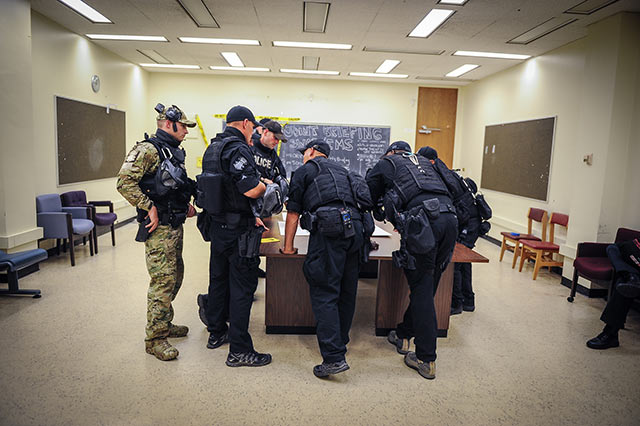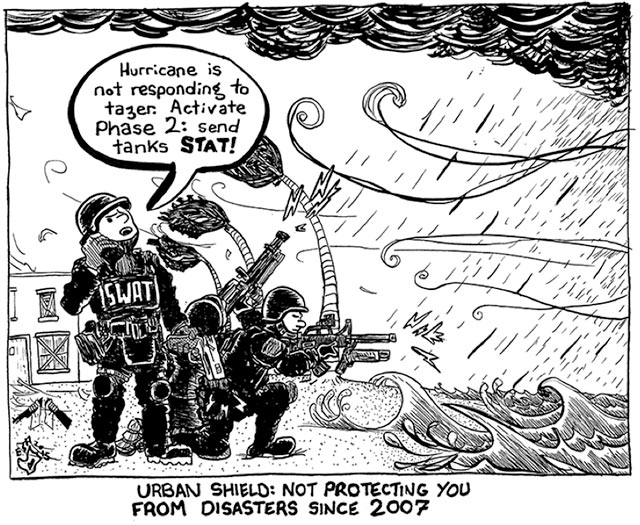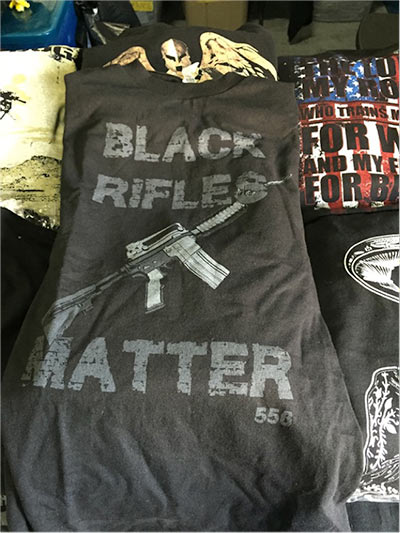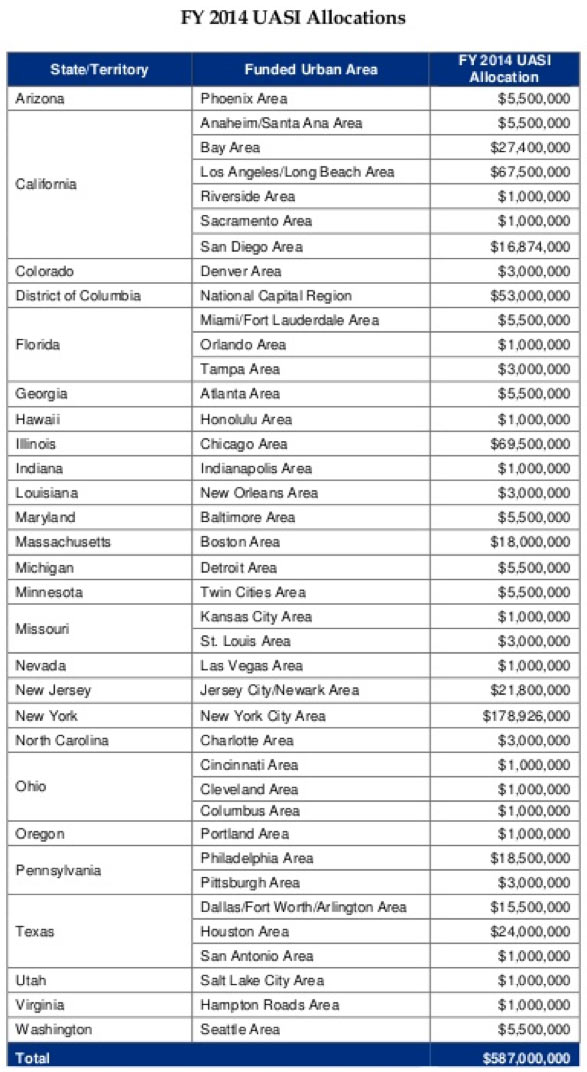
Urban Shield, the world’s largest SWAT training and war-weapons expo, was held in September in California’s Bay Area, beginning on the 14th anniversary of 9/11. Hosted each year since 2007 in the Bay Area’s Alameda County (last year in Oakland, this year in Pleasanton) with exercises all across the Bay, it is attended by hundreds of local, federal and international law enforcement agencies and weapons manufacturers.
Since his tenure began in 2007, Alameda County’s sheriff, Gregory J. Ahern, has been waging war on Black and Brown communities across the Bay Area. Urban Shield solidifies Ahern’s war, and makes it a profitable one. As the Bay Area Urban Shield’s core organizer, he has received over $100,000 in contributions for his electoral campaign from Urban Shield vendors, such as 511 Tactical, Adamson Police Products and Corizon Health. But he’s not the only one. Local, federal and international agencies coordinate through police trainings and weapons expos all over the world, much like Urban Shield, to trade tactics and military-grade weaponry.
Urban Shield is just one such police militarization expo: a convenient “one-stop shop” for anything a police department might need to turn regular beat cops into SWAT-like robo-cops. Granted, Alameda County police forces were committing brutality long before Urban Shield first began in 2007. It has been occurring since the mid-1960s to 1980s, as high-level military equipment and techniques were nationally transferred to police departments for “war on drugs” activities. Post-9/11 saw a morphing of these weapons transfer programs between the military and police for the “war on terror” and for the “enhancement of officer safety.” However, the centralizing and systematizing of militarism, and police militarization in particular, under the guise of emergency preparedness and public safety, is a relatively new and expanding phenomena of police militarization, with Urban Shield as one of the clearest and most spectacular examples of how the militarism of state violence drives deeper into US communities.
 (Cartoon: Ethan Heitner for the War Resisters League)
(Cartoon: Ethan Heitner for the War Resisters League)
Urban Shield brings together police departments, SWAT teams, fire departments and emergency medical services to partake in training exercises and attend the expo featuring global arms manufacturers’ newest surveillance and weapons technology, from drones and armored vehicles to DNA-identification machines. Urban Shield appeals to growing fears of climate change emergencies and natural disasters, by selling itself as an “emergency preparedness exercise” for “high-threat, high-density urban areas.” However, because Urban Shield is funded by the Department of Homeland Security, all training scenarios, workshop topics and vendor goods at the expo have to have a “nexus to terrorist threats.” The weekend of September 11 to 14 effectively functioned as an international counterterrorism conference. Simply put, Urban Shield is selling militarism.
 (Photo: Julia Carrie Wong)While Urban Shield’s flashier items for sale in Oakland, such as aerial weapons and armored tanks, continue to draw much media attention year to year, militarism takes other forms as well: This year at Urban Shield, T-shirts were sold with slogans such as “Black Rifles Matter” and in 2014, “This Is My Peace Sign,” with a picture of a gun scope. Militarism comes in obvious forms, from weapons to surveillance technology, but militarism – the state of mind that is required in order to maintain global and national state control – is also spread through humor, “gaming” culture and a normalization of violence against those already deemed disposable, dangerous and/or “radical.” It is only then that militarized mentalities – mentalities that rely heavily on cultures of fear, white supremacy, heteropatriarchy and warfare logic – successfully permeate through agencies, such as police departments, and dramatically amplify the force of police violence through our communities.
(Photo: Julia Carrie Wong)While Urban Shield’s flashier items for sale in Oakland, such as aerial weapons and armored tanks, continue to draw much media attention year to year, militarism takes other forms as well: This year at Urban Shield, T-shirts were sold with slogans such as “Black Rifles Matter” and in 2014, “This Is My Peace Sign,” with a picture of a gun scope. Militarism comes in obvious forms, from weapons to surveillance technology, but militarism – the state of mind that is required in order to maintain global and national state control – is also spread through humor, “gaming” culture and a normalization of violence against those already deemed disposable, dangerous and/or “radical.” It is only then that militarized mentalities – mentalities that rely heavily on cultures of fear, white supremacy, heteropatriarchy and warfare logic – successfully permeate through agencies, such as police departments, and dramatically amplify the force of police violence through our communities.
The Urban Areas Security Initiative
Though coordinated by the Alameda County Sheriff’s Office, Urban Shield is actually made possible through the Urban Areas Security Initiative, or UASI, a grant program of the US Department of Homeland Security (DHS). UASI is an almost $600 million grant program from DHS, which is administered through the Federal Emergency Management Agency (FEMA) to grant funding to agencies across the United States. UASI strengthens and unifies state repression, though they claim to be a program that assists 39 “high-threat, high-density Urban Areas in efforts to build and sustain the capabilities necessary to prevent, protect against, mitigate, respond to, and recover from acts of terrorism.” In response to controversy over “the [DHS] funding formula [for high-threat urban areas], in April 2003, Congress introduced the Urban Area Security Initiative (UASI), which was intended to supplement the security budgets of the most vulnerable cities.” However, according to a New York City official, “The aid is not based on threat. It’s based on formulas that allow the government to spread it around the country. That’s politics; that’s not threat assessment.”
UASI and Urban Shield are expanding: UASI grew by nearly $30 million in 2014 alone, and since 2007, Urban Shield has been hosted in Oakland and Pleasanton, California; Boston, Massachusetts; as well as central Texas (Fort Worth, Dallas and Austin). The highest recipient of UASI funding is the New York City area, which received $178 million in 2014, perhaps funding New York City Police Department Commissioner William Bratton’s “strategic response group” counterterrorism units this year. In descending order after New York, the highest recipient areas of UASI are Chicago, Los Angeles/Long Beach, National Capital, Bay Area and Houston, all above $20 million annually. While some UASI funding is spent on expos such as Urban Shield, other cities obtain war toys, such as Chicago’s surveillance cameras, BearCat armored trucks in Fargo, North Dakota, and Keene, New Hampshire, and Long Beach’s armored cars.
 (Chart: UASI)
(Chart: UASI)
In the Bay Area, however, for the period of November 1, 2014, to February 28, 2016, Alameda County has received $6,358,300 in funding from UASI. Of this, $1.7 million is designated to Urban Shield. The Alameda County Sheriff’s Office does not receive any funds from Urban Shield to offset the costs of holding such activities in the Bay Area, thus causing the county to pay using the hard-earned money of its people. Urban Shield states that it “has no funds available to offset the costs of overtime for employees who may wish to participate in the exercise planning or on the dates of the exercise itself. Nor does Urban Shield pay to offset the costs of backfilling on-duty employees who wish to participate.” However, the county accepts these conditions of costing the people in order to secure funding through UASI.
Resisting Militarization
The Stop Urban Shield Coalition, based in Oakland, California, is a unique example of a cross-community grassroots effort united to resist militarization of Black and Brown communities. From local, community-based organizations to national organizations, the Stop Urban Shield Coalition includes members from various race, faith, political and social backgrounds, though it unites around following the leadership of those most impacted by policing and militarization. The coalition calls for “decreasing violence in our communities by ending police militarization, an end to the use of our communities as testing grounds for tactics of global repression, to affirm our right to community self-determination, and on our communities to continue fighting back and resisting state violence and repression.”
Urban Shield normalizes the constant state of militarized emergency in marginalized communities across the nation.
In 2014, the Stop Urban Shield Coalition successfully pressured city administrators enough that on the first day of the expo, Oakland Mayor Jean Quan announced Urban Shield would no longer be held in Oakland city borders. While momentarily exciting, with time it became clear that Urban Shield merely moved to Pleasanton, a town near Oakland, and still in Alameda County. Because the coalition’s goal is to end Urban Shield and hold our cities and counties accountable in their collaboration in racialized repression and violence, the coalition again organized Bay Area residents this year to push city administrators to reject Urban Shield from Alameda County completely. From organizing a national call-in day to Alameda County’s Board of Supervisors, appealing to them to stand with communities, not war profiteers, to blocking traffic with guerrilla theatre and hosting a rally outside of the Alameda County Sheriff’s Office building, the Stop Urban Shield coalition used many organizing tactics to draw attention to the real impacts of police militarization on communities, particularly people of color. Far from training agencies for emergency preparedness, the Stop Urban Shield Coalition argues that Urban Shield normalizes the constant state of militarized emergency in Black, Arab, Muslim, migrant and poor communities across the nation.
While it is clear how Urban Shield will affect communities across the Bay Area, as well as any towns and countries with police departments that attend the Urban Shield trainings, the effect of emergency respondents and fire fighters attending militarized SWAT trainings rife with anti-Black and Islamophobic tropes is less clear. Urban Shield training increasingly includes scenarios that involve “homegrown domestic terrorists” and political protesters. In 2014, Urban Shield Bay Area hosted a training exercise based at the University of California, Berkeley, where competitors were presented with a scenario of a “Muslim man that took a Jewish man hostage” who had “read a website on jihad against Israel,” and was going to use chemical weapons to “hurt the Jew for what he’s done to his people.” This dramatic scenario only fuels the already normalized trope of terrorist Muslim, but also suggests that “a military grade response, like those used in US wars against Iraq and Afghanistan or in support of the apartheid state of Israel against Palestine is appropriate for law enforcement to take in day-to-day contact with Arab and Muslim communities,” according to Rachel Herzing in the brief “Why Arab and Muslim communities should say No to Urban Shield.” Furthermore, Arab and Muslim communities have been targeted by the Department of Homeland Security, the FBI, the Joint Terrorism Task Force and other federal agencies through surveillance, police harassment, physical brutality and arrest since 9/11.
The Islamophobic profiling and criminalization enacted within the United States as part of the “war on terror” further the fear and distrust of Muslim, Arab and Middle Eastern communities. Inside Urban Shield’s trade show, vendors push the same surveillance technologies and weapons that have been used in repressing Black communities in Ferguson, Baltimore and nationally, and these same technologies have also been used against Arab and Muslim communities across the country and globe. Employing militarized weapons and tactics to policing strategies – whether biometric or drone surveillance, SWAT raids and no-knock entries, or armored personnel carriers – targets the communities against which they’re used as enemies to be neutralized. These weapons and tactics can be even more harmful when they are aimed at a community already targeted as enemies inside the United States.
SWAT Raids and Racist Policing
Black, Indigenous, Chicana and Muslim communities, communities of color and poor people, particularly homeless people, are most impacted by police militarization, including SWAT raids, extrajudicial killings, police brutality, racial profiling, suspicious activity reporting policies, fusion centers and the rapidly expanding prison industrial complex. In the United States, according to the Bureau of Justice Statistics, Black people are arrested at about double the rate of white people and at a proportionally higher rate than any other racial group. As the foot soldiers of the notoriously racist “war on drugs,” SWAT teams have historically brought a war-making mentality to the daily practice of policing and arrest. The state profiled Black and Latino men as the primary targets for this war, and the police trained to carry the war out and treat them as threats to be neutralized. However, those impacted by SWAT raiding of targets, such as children and families, are voices often unheard.
Maria Calvillo, a 13-year-old member of Xicana Moratorium Coalition (XMC), speaking at a September 11 Stop Urban Shield rally in Oakland, described her home being raided by SWAT in the middle of the night while she was home with her mother and baby sister. “As soon as I hit the door, I opened it and they started screaming at me, tell me to put my hands up, pointing rifles at me,” she told Truthout. “I looked around, and it seemed like a movie, I couldn’t believe it…. The police had a tank in front of our house. An actual tank.”
If we push Urban Shield, a product of the global war on terror, out of the US, we delegitimize the US war machine at its core.
The murder of Aiyana Jones, a 7-year-old girl who was shot in a Detroit no-knock SWAT raid in 2010 after a flash grenade was thrown through the front window, made abundantly clear how war mentalities are enacted through SWAT killings. SWAT teams are deployed nearly 50,000 times per year. According to The Economist, “Roughly 90% of all police departments in cities with populations over 50,000 have a variation of a SWAT team, as do federal departments including the Department of Agriculture and the Department of Education. Given the frequency with which SWAT is employed by law enforcements, we can see that SWAT isn’t so much specialized policing as the mainstay these days.”
Urban Shield focuses heavily on SWAT teams. According to the American Civil Liberties Union (ACLU), 39 percent of people impacted by SWAT deployments are Black versus 20 percent for white people (Black people make up about 13 percent of the US population and white people about 63 percent). SWAT-style teams (sometimes named “counterterrorism” or “strategic response”) are also frequently deployed to suppress protests and political dissent. Recent examples from Occupy and the Black protest movement provide clear demonstrations of how quickly policing tactics escalate through militarism, regardless of the types of cops on the streets. For anyone engaged in direct action and civil disobedience, and in particular for policed peoples, the danger of interaction with police deployed to suppress dissent should not be underestimated.
Police departments from around the world, counterterrorism units and border patrol agencies come each year to Urban Shield to partake in the trading of tactics of state repression, crowd control and weapons technology. In past years, agencies from Israel, Bahrain, Greece, Singapore, Brazil, Jordan, Qatar, the United Arab Emirates and Canada have participated in Urban Shield. This year’s Urban Shield hosted domestic police from Texas and Florida, and international teams from South Korea, Jordan, Uruguay, Colombia, Thailand and China. Organizers of these types of gatherings often proudly claim that the next will be “more international than ever.”
This kind of collaboration impacts every policed person around the world, including those under formal colonial occupations and those under neo-imperialist regimes. Further, Urban Shield’s reach is felt globally, with platinum vendors featured such as Safariland. This key weapons manufacturer exports tear gas and other repressive technologies to Brazil, Bahrain and Canada, just to name a few. The day after Urban Shield closed, on September 15, London’s Defense and Security Equipment International (DSEI), the largest arms fair in the world began, hosting many of the same vendors, such as BAE Systems, the third-largest arms producer from warships to missiles.
 (Cartoon: Ethan Heitner for the War Resisters League)
(Cartoon: Ethan Heitner for the War Resisters League)
It is obvious to us as Black and Muslim activists in the United States that our communities are connected through the ways we are targeted. But we can also connect through the power of our organizing. The Stop Urban Shield Coalition provides a unique example of how to build power across our races, religions, classes and sects, and connect urban area to urban area to resist militarization nationally. If we push Urban Shield, a product of the global war on terror, out of the United States, and disempower police departments, the Department of Homeland Security and the Department of Defense, we delegitimize the US war machine at its core. Then we can really begin to resist militarism around the world.
Note: Rachel Herzing and Loubna Qutami contributed to this piece.
Join us in defending the truth before it’s too late
The future of independent journalism is uncertain, and the consequences of losing it are too grave to ignore. To ensure Truthout remains safe, strong, and free, we need to raise $46,000 in the next 7 days. Every dollar raised goes directly toward the costs of producing news you can trust.
Please give what you can — because by supporting us with a tax-deductible donation, you’re not just preserving a source of news, you’re helping to safeguard what’s left of our democracy.